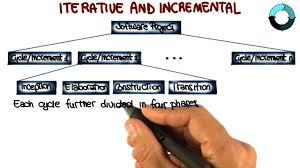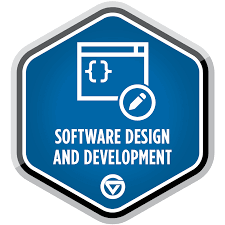Iterative Software Development: A Path to Success
In the fast-paced world of software development, the need for efficient and effective project management methodologies is paramount. One such approach that has gained significant popularity is iterative software development. This methodology emphasizes flexibility, collaboration, and continuous improvement throughout the development process.
Iterative software development is based on the concept of breaking down a project into smaller, manageable iterations or cycles. Each iteration involves planning, designing, coding, testing, and evaluating a specific set of features or functionalities. The key idea behind this approach is to deliver working software in incremental stages rather than waiting until the entire project is complete.
One of the main advantages of iterative development is its ability to adapt to changing requirements. In traditional waterfall methodologies, changes in requirements during later stages can be costly and time-consuming to implement. However, with an iterative approach, changes can be easily incorporated at the end of each iteration. This flexibility allows for greater customer satisfaction as their evolving needs can be met throughout the development process.
Collaboration plays a crucial role in iterative software development. By involving stakeholders and end-users early on in the process, developers gain valuable insights and feedback that can shape subsequent iterations. Continuous communication between team members fosters transparency and ensures that everyone is aligned with project goals and objectives.
The iterative model also enables developers to identify potential risks or challenges early on. By regularly testing and evaluating each iteration, issues can be identified and resolved promptly before they escalate into major problems. This proactive approach helps minimize risks associated with cost overruns or missed deadlines.
Furthermore, iterative software development promotes continuous improvement by allowing teams to learn from their experiences. Through regular retrospectives at the end of each iteration, team members reflect on what worked well and what could be improved upon in subsequent cycles. This feedback loop encourages innovation and drives efficiency by encouraging teams to refine their processes over time.
It’s important to note that while iterative software development offers numerous benefits, it requires a disciplined and well-organized team. Effective project management, clear communication, and proper documentation are essential to ensure that each iteration builds upon the previous one seamlessly.
In conclusion, iterative software development is a dynamic and flexible approach that enables teams to deliver high-quality software in an incremental manner. By embracing collaboration, adaptability, and continuous improvement, developers can create products that meet evolving customer needs while minimizing risks and maximizing efficiency. As the software industry continues to evolve rapidly, adopting iterative methodologies can be a key factor in achieving success in today’s competitive landscape.
8 Essential Tips for Successful Iterative Software Development
- Make sure to plan and prioritize tasks in advance.
- Establish clear goals and objectives before you begin development.
- Utilize feedback loops to continuously improve the product over time.
- Develop a timeline for each iteration and stick to it as much as possible.
- Test often, early, and thoroughly throughout the development process to catch any bugs or issues quickly.
- Design with scalability in mind from the start so that changes can be made easily down the line if needed.
- Take advantage of automation tools where possible to streamline processes and save time on repetitive tasks such as testing or deployment.
- Communicate regularly with stakeholders throughout the process to ensure everyone is on the same page about progress, expectations, and changes being made along the way
Make sure to plan and prioritize tasks in advance.
The Importance of Planning and Prioritizing in Iterative Software Development
In the world of iterative software development, planning and prioritizing tasks play a crucial role in ensuring the success of a project. By taking the time to carefully plan and prioritize, development teams can streamline their workflow, optimize resources, and deliver high-quality software within each iteration.
When it comes to planning, it’s essential to have a clear understanding of the project’s goals and objectives. This involves breaking down the overall scope into smaller, manageable tasks that can be completed within each iteration. By defining specific deliverables for each cycle, developers can maintain focus and work towards tangible milestones.
Effective planning also involves estimating the effort required for each task. By assigning realistic timeframes and allocating resources accordingly, teams can ensure that they have sufficient capacity to complete the planned work within each iteration. This helps prevent overcommitment or underutilization of resources, leading to better productivity and improved efficiency.
Prioritization is equally important in iterative software development. Not all tasks are created equal, and some may have a higher impact on the project’s success than others. By prioritizing tasks based on their importance and urgency, developers can ensure that critical features or functionalities are addressed early on in the process.
One popular technique for prioritization is using techniques like MoSCoW (Must-have, Should-have, Could-have, Won’t-have) or Eisenhower Matrix (Urgent vs Important). These methods help teams identify which tasks are essential for meeting project requirements and which ones can be deferred to subsequent iterations.
By planning and prioritizing effectively, development teams gain several advantages. First, it allows stakeholders to have a clear understanding of what will be delivered in each iteration, promoting transparency and managing expectations. Second, it helps prevent scope creep by ensuring that all planned work aligns with project objectives.
Furthermore, planning and prioritization enable teams to make informed decisions when unexpected changes or challenges arise. By having a well-defined roadmap, developers can quickly assess the impact of changes and adjust their plans accordingly without derailing the entire project.
In conclusion, planning and prioritizing tasks are essential components of successful iterative software development. By investing time upfront to define goals, estimate effort, and prioritize tasks, teams can streamline their workflow, optimize resources, and deliver high-quality software within each iteration. This approach not only enhances productivity but also ensures that critical features are addressed promptly, leading to customer satisfaction and project success.
Establish clear goals and objectives before you begin development.
In the realm of iterative software development, setting clear goals and objectives at the outset is crucial for a successful project. By defining these parameters early on, teams can align their efforts, streamline their processes, and ensure that their development cycles are focused and purposeful.
When embarking on a software development project, it is essential to have a clear understanding of what needs to be achieved. This involves identifying the specific features, functionalities, or problems that the software aims to address. By clearly defining these goals and objectives, you provide a roadmap for your team to follow throughout the iterative process.
Setting clear goals helps in prioritizing tasks and allocating resources effectively. It allows developers to identify which features are most critical or urgent and ensures that they receive appropriate attention during each iteration. This approach prevents scope creep and helps maintain focus on delivering value to end-users.
Moreover, establishing clear goals enables effective communication with stakeholders. By clearly articulating project objectives from the start, you can manage expectations and ensure that everyone involved understands what is being developed. This not only fosters transparency but also helps build trust among team members, clients, or users.
Clear goals also provide a benchmark for progress evaluation. As each iteration is completed, you can assess whether the defined objectives were met or if adjustments need to be made moving forward. Regularly reviewing progress against these goals allows for course corrections if necessary and ensures that the project stays on track.
Additionally, having well-defined goals facilitates collaboration within the development team. When everyone shares a common understanding of what needs to be accomplished, it becomes easier to coordinate efforts and work towards a shared vision. Developers can align their tasks based on these objectives and collaborate more efficiently throughout each iteration.
In conclusion, establishing clear goals and objectives before beginning iterative software development is vital for project success. It provides direction, aids in resource allocation, facilitates effective communication with stakeholders, enables progress evaluation, and enhances collaboration within the development team. By setting a clear path from the start, you lay the foundation for a streamlined and purpose-driven development process that increases the likelihood of delivering a successful software product.
Utilize feedback loops to continuously improve the product over time.
Utilize Feedback Loops: Enhancing Product Excellence through Iterative Software Development
In the world of iterative software development, one crucial tip stands out as a guiding principle for success: Utilize feedback loops to continuously improve the product over time. This practice not only enhances the quality of the software but also ensures that it meets the evolving needs and expectations of end-users.
Feedback loops are an integral part of the iterative development process. They provide valuable insights and perspectives from stakeholders, customers, and end-users, enabling developers to make informed decisions and drive product excellence. By actively seeking feedback throughout each iteration, teams can identify areas for improvement, address issues promptly, and refine their approach accordingly.
One of the primary advantages of feedback loops is their ability to bridge the gap between developers and end-users. By involving users early on in the process, developers gain a deeper understanding of their preferences, pain points, and desired features. This knowledge allows them to tailor subsequent iterations to better meet user expectations.
Regular feedback also helps identify potential usability issues or bugs that may have been overlooked during development. By collecting user input at various stages of the project, developers can quickly detect and rectify any issues before they impact user experience or satisfaction. This proactive approach not only enhances product quality but also saves time and resources in the long run.
Furthermore, feedback loops foster a culture of continuous improvement within development teams. By encouraging open communication and collaboration among team members, everyone can learn from each other’s experiences and insights. This shared knowledge helps refine processes, enhance efficiency, and drive innovation over time.
To effectively utilize feedback loops in iterative software development, it’s essential to establish clear channels for communication with stakeholders and end-users. This can be done through surveys, interviews, user testing sessions, or dedicated feedback mechanisms within the software itself. It’s crucial to actively listen to users’ opinions and suggestions while remaining open-minded about potential improvements.
It’s important to note that feedback loops should not be limited to the development phase alone. They should continue even after the product is released, as ongoing user feedback can provide valuable insights for future updates and enhancements. By maintaining a continuous feedback loop, developers can ensure that the software remains relevant and competitive in an ever-changing market.
In conclusion, utilizing feedback loops is a powerful tip in iterative software development. By actively seeking and incorporating user feedback throughout the development process, teams can enhance the quality of their products, meet user expectations, and drive continuous improvement. Embracing this practice fosters collaboration, innovation, and ultimately leads to a more successful and user-centric software solution.
Develop a timeline for each iteration and stick to it as much as possible.
Develop a Timeline for Each Iteration: A Key to Iterative Software Development Success
In the world of iterative software development, one crucial tip stands out: develop a timeline for each iteration and stick to it as much as possible. This practice plays a vital role in ensuring the smooth progress and success of your software development projects.
When embarking on an iterative approach, it is essential to break down your project into smaller, manageable iterations. Each iteration should have a clear timeline that outlines the tasks, milestones, and deadlines. By having a well-defined timeline, you set expectations and create a roadmap that guides your team throughout the development process.
Developing a timeline for each iteration serves several purposes. First and foremost, it helps you stay organized and focused on specific goals within a given timeframe. It ensures that everyone involved understands what needs to be accomplished during that iteration and when it needs to be completed.
Sticking to the timeline fosters discipline within your team. It encourages everyone to work efficiently and prioritize tasks effectively. By adhering to deadlines, you create a sense of accountability among team members, which leads to improved productivity.
Moreover, having timelines for each iteration allows you to monitor progress effectively. Regularly tracking milestones against the established schedule helps identify any potential bottlenecks or delays early on. This proactive approach enables you to take corrective actions promptly, minimizing disruptions and ensuring that the project stays on track.
However, it’s important to note that while developing a timeline is crucial, flexibility is also key in iterative software development. The nature of this methodology allows for adjustments as new insights emerge or priorities shift during the development process. Therefore, while sticking as closely as possible to the established timeline is important, being open to necessary adjustments is equally essential.
To maximize the effectiveness of your timelines in iterative software development, consider involving your team members in their creation. Seek their input regarding task estimates and feasibility assessments when setting deadlines. This collaborative approach fosters engagement and empowers team members to take ownership of their responsibilities.
In conclusion, developing a timeline for each iteration and adhering to it as much as possible is a valuable tip in iterative software development. It promotes organization, accountability, and effective progress tracking throughout the project. By setting clear expectations and maintaining discipline, you increase the likelihood of successfully delivering high-quality software within the designated timeframes.
Test often, early, and thoroughly throughout the development process to catch any bugs or issues quickly.
The Importance of Testing in Iterative Software Development
In the world of software development, testing is an essential component that ensures the quality and reliability of the final product. When it comes to iterative software development, the significance of testing becomes even more pronounced. Testing often, early, and thoroughly throughout the development process is a crucial tip that can save time, effort, and resources in the long run.
Testing early in the iterative development cycle allows for the identification and resolution of bugs or issues at an early stage. By catching these problems sooner rather than later, developers can prevent them from compounding and affecting subsequent iterations. This approach not only helps maintain a smooth development process but also enhances overall productivity.
Frequent testing also enables developers to validate their assumptions and verify that each iteration meets the desired functionality requirements. It provides an opportunity to assess whether the implemented features are working as intended and align with user expectations. By conducting regular tests, any deviations or discrepancies can be detected promptly, allowing for necessary adjustments to be made.
Thorough testing is another crucial aspect of iterative software development. It involves examining different aspects of the software, including functionality, performance, security, and usability. Comprehensive testing helps uncover hidden bugs or vulnerabilities that may not be apparent during initial development stages. By addressing these issues proactively, developers can deliver a more robust and reliable product.
Moreover, thorough testing contributes to building customer confidence in the software being developed. When customers see that their feedback is being taken seriously and that rigorous testing is being conducted throughout the process, it instills trust in the final product’s quality. This trust can lead to increased customer satisfaction and loyalty.
Incorporating automated testing tools into an iterative development workflow can further streamline the process. Automated tests allow for quick execution and repetitive validation of functionalities across multiple iterations. This approach reduces human error while saving time and effort associated with manual testing.
In conclusion, testing often, early, and thoroughly is a valuable tip for successful iterative software development. By catching bugs and issues early on, developers can prevent them from escalating and impacting subsequent iterations. Regular testing helps validate assumptions, ensure functionality alignment, and enhance overall product quality. With thorough testing, developers can deliver a reliable software solution that meets customer expectations while building trust and satisfaction.
Design with scalability in mind from the start so that changes can be made easily down the line if needed.
Designing with Scalability in Mind: A Key to Iterative Software Development
In the world of software development, change is inevitable. Requirements evolve, user needs shift, and technology advances at a rapid pace. To navigate these changes effectively, it is crucial to design software with scalability in mind right from the start. This proactive approach ensures that future modifications and enhancements can be made easily down the line, without causing significant disruptions or delays.
When designing software with scalability in mind, it’s essential to consider both functional and technical aspects. On the functional side, understanding the potential growth and expansion of features or functionalities is crucial. By anticipating future requirements and designing flexible modules or components, developers can ensure that adding new features or modifying existing ones becomes a seamless process.
Additionally, considering technical scalability is equally important. This involves designing software architecture that can handle increasing data volumes, user traffic, or system complexity without compromising performance or stability. By employing scalable technologies and frameworks from the outset, developers can avoid costly rework later on.
Iterative software development perfectly complements this approach by allowing for incremental improvements and adjustments over time. With each iteration, the software evolves based on user feedback and changing requirements. By designing with scalability in mind during these iterations, developers can easily incorporate necessary changes without disrupting the overall system.
The benefits of designing for scalability extend beyond just accommodating future changes. It also leads to improved maintainability and reduced technical debt. When software is designed with scalability in mind, it tends to have cleaner code structures and modular components that are easier to understand and maintain.
Moreover, designing for scalability fosters a more agile development process. As new requirements emerge or business priorities shift, teams can quickly adapt without having to overhaul the entire system. This agility provides a competitive advantage by enabling faster time-to-market for new features or updates.
In conclusion, designing with scalability in mind is a vital tip for successful iterative software development. By anticipating future needs and designing flexible, scalable solutions, developers can ensure that changes can be easily incorporated down the line. This approach not only promotes adaptability and agility but also enhances maintainability and reduces technical debt. Embracing scalability from the start sets the foundation for a robust and future-proof software system that can evolve with changing requirements and technology advancements.
Take advantage of automation tools where possible to streamline processes and save time on repetitive tasks such as testing or deployment.
Streamlining Software Development with Automation Tools
In the world of iterative software development, efficiency is key. One effective way to boost productivity and save valuable time is by leveraging automation tools. These tools can help streamline processes and alleviate the burden of repetitive tasks, such as testing or deployment.
Automation tools offer a range of benefits for software development teams. By automating routine tasks, developers can focus their time and energy on more critical aspects of the project, such as code quality and feature development. This not only increases productivity but also improves overall software quality.
One area where automation tools prove particularly useful is in testing. Manual testing can be time-consuming and prone to human error. With automation tools, developers can create test scripts that automatically execute test cases, validate expected outcomes, and identify any issues or bugs. This not only saves time but also ensures thorough and consistent testing across different iterations.
Deployment is another area where automation tools shine. The process of deploying software to various environments can be complex and error-prone if done manually. Automation tools allow for the creation of deployment pipelines that automate the build, testing, and deployment stages. This eliminates manual intervention and reduces the risk of errors during deployment.
Furthermore, automation tools enable continuous integration and continuous delivery (CI/CD) practices. CI/CD allows for frequent code integration into a shared repository while ensuring automated builds, tests, and deployments at every stage. This approach promotes collaboration among team members and accelerates the delivery of new features or bug fixes to end-users.
By taking advantage of automation tools throughout the iterative software development process, teams can achieve greater efficiency, reduce human error, and enhance overall product quality. However, it’s important to choose appropriate tools that align with project requirements and team capabilities.
When implementing automation tools, it’s crucial to strike a balance between manual intervention and complete reliance on automation. While automation offers significant advantages in terms of speed and accuracy, some tasks may still require human expertise and judgment. Regular monitoring and fine-tuning of automation processes are essential to ensure optimal results.
In conclusion, automation tools are invaluable assets for software development teams practicing iterative methodologies. By automating repetitive tasks such as testing or deployment, developers can save time, enhance productivity, and improve the overall quality of their software. Embracing automation not only streamlines processes but also empowers teams to focus on innovation and delivering value to end-users.
Communicate regularly with stakeholders throughout the process to ensure everyone is on the same page about progress, expectations, and changes being made along the way
Effective Communication: The Key to Successful Iterative Software Development
In the world of iterative software development, one tip stands out as paramount: regular communication with stakeholders. Keeping everyone involved informed and on the same page throughout the process is essential for success. By maintaining open lines of communication, teams can ensure that progress, expectations, and changes are well understood and aligned.
Iterative software development thrives on collaboration and feedback. By involving stakeholders from the early stages of a project, developers gain valuable insights into their needs and expectations. Regular communication allows for a continuous exchange of ideas, enabling teams to address any concerns or questions promptly.
Keeping stakeholders informed about progress is crucial. Regular updates on completed iterations, milestones achieved, and upcoming tasks provide transparency and build trust. This information helps stakeholders understand the project’s trajectory and manage their expectations accordingly.
Additionally, communicating changes being made along the way is vital for successful iterative development. As requirements evolve or new insights emerge during each iteration, it’s important to keep stakeholders aware of these adjustments. By involving them in decision-making processes related to changes, teams can ensure that everyone understands why modifications are being made and how they will impact the final product.
Clear communication also helps manage potential risks or challenges effectively. If issues arise during an iteration, promptly informing stakeholders allows for collaborative problem-solving. This proactive approach ensures that any necessary adjustments can be made swiftly without compromising project timelines or quality.
When it comes to communication in iterative software development, choosing the right channels is crucial. Regular meetings, emails, status reports, or even dedicated collaboration tools can facilitate effective information exchange among team members and stakeholders alike.
In conclusion, regular communication with stakeholders throughout the iterative software development process is essential for success. By keeping everyone informed about progress, managing expectations effectively, and involving them in decision-making processes related to changes being made along the way, teams can foster collaboration and ensure alignment towards project goals. Clear communication builds trust among all parties involved and helps deliver a high-quality product that meets stakeholders’ needs and requirements.




